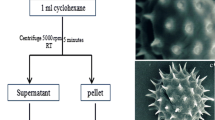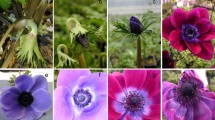Abstract
The hormonal status of the pollen-pistil system in Petunia hybrida L. during the progamic phase of fertilization was investigated. The contents of indolyl-3-acetic acid (IAA), abscisic acid (ABA), and cytokinins, as well as the rate of ethylene production in the pistils and their parts (stigma, style, and ovary) were measured over an 8-h period following compatible and self-incompatible pollination. In both pollinations, the phytohormones were present in various proportions in the stigma, style and ovary: the stigma was the main site of ethylene synthesis and contained 90% of the ABA, while the style contained 80% of the total cytokinin content in the pollinated pistil. Relatively low levels of hormones in the ovary did not influence the hormonal status of the pollen-pistil system. The interaction of the male gametophyte with the stigmatic tissues was accompanied by a 7- to 10-fold increase in ethylene production and a 1.5- to 2.0-fold increase in IAA content in the pollen-pistil system over 0–4 h. Pollen tube growth after self-incompatible pollination, in contrast to compatible pollination, was accompanied by a 3-fold increase in the ABA content in the stigma and style and by a 5-fold higher cytokinin content in the stylar tissues. Thus, the ethylene/ABA status of the stigma may play a role in controlling the processes of adhesion, hydration, and germination of pollen grains during pollination while the auxin/cytokinin status of the style may be involved in controlling pollen tube growth.



Similar content being viewed by others
References
Baker RP, Hasenstein KH (1997) Hormonal changes after compatible and incompatible pollination in Theobroma cacao L. Hortic Sci 32:1231–1234
Barendse GWM, Pereira ASR, Berkers PA, Driessen FM, van Eyden-Emons A, Linskens HF (1970) Growth hormones in pollen, styles and ovaries of Petunia hybrida and of Lilium species. Acta Bot Neerl 19:175–185
Beveridge CA, Weller JL, Singer SR, Hofer JMI (2003) Axillary meristem development. Budding relationships between networks controlling flowering, branching, and photoperiod responsiveness. Plant Physiol 131:927–934
Chae HS, Faure F, Kieber JJ (2003) The eto1, eto2, and eto3 mutants and cytokinin treatment increase ethylene biosynthesis in Arabidopsis by increasing stability of ACS protein. Plant Cell 15:545–559
Cheng W-H, Endo A, Zhou L, Penney J, Chen H-C, Arroyo A, Leon P, Nambara E, Asami T, Seo M, Koshiba T, Sheen J (2002) A unique short-chain dehydrogenase/reductase in Arabidopsis glucose signaling and abscisic acid biosynthesis and functions. Plant Cell 14:2723–2743
Coenen C, Lomax TL (1997) Auxin-cytokinin interactions in higher plants: old problems and new tools. Trends Plant Sci 2:351–356
Cruz-Garcia F, Hancock CN, McClure B (2003) S-RNase complexes and pollen rejection. J Exp Bot 54:123–130
Dixit R, Rizzo C, Nasrallah M, Nasrallah J (2001) The Brassica MIP-MOD gene encodes a functional water channel that is expressed in the stigma epidermis. Plant Mol Biol 45:51–62
Eckardt NA (2002) Abscisic acid biosynthesis gene underscores the complexity of sugar, stress, and hormone interactions. Plant Cell 14:2645–2649
Franklin-Tong VE (1999) Signalling and the modulation of pollen tube growth. Plant Cell 11:727–738
Fu X, Harberd NP (2003) Auxin promotes Arabidopsis root growth by modulating gibberellin response. Nature 421:740–743
Geitmann A, Cresti M (1998) Ca2+ channels control the rapid expansion in pulsating growth of Petunia hybrida pollen tubes. J Plant Physiol 152:439–447
Graaf BHJ de, Derksen JWM, Mariani C (2001) Pollen and pistil in the progamic phase. Sex Plant Reprod 14:41–55
Gu Y, Vernoud V, Fu Y, Yang Z (2003) ROP GTPase regulation of pollen tube growth through the dynamics of tip-localized F-actin. J Exp Bot 54:93–101
Hansen H, Grossmann K (2000) Auxin-induced ethylene triggers abscisic acid biosynthesis and growth inhibition. Plant Physiol 124:1437–1448
Harrison MA, Kaufman PB (1984) The role of hormone transport and metabolism in apical dominance in oats. Bot Gaz 145:293–297
Haver DL, Schuch UK, Lovatt CJ (2003) Exposure of Petunia seedlings to ethylene decreased apical dominance by reducing the ratio of auxin to cytokinin. J Plant Growth Regul 21:459–468
Hepler RK, Vidali L, Cheung AY (2001) Polarized cell growth in higher plants. Annu Rev Cell Dev Biol 17:159–187
Huang JC, Lin SM, Wang CS (2000) A pollen-specific and desiccation-associated transcript in Lilium longiflorum during development and stress. Plant Cell Physiol 41:477–485
Knox RB (1984) Pollen-pistil interactions. In: Linskens HF, Heslop-Harrison J (eds) Encyclopaedia of plant physiology, new series. Springer, Berlin Heidelberg New York, pp 17:508–608
Leyser O (2001) Auxin signaling: the beginning, the middle and the end. Curr Opin Plant Biol 4:382–386
Lord EM (2003) Adhesion and guidance in compatible pollination. J Exp Bot 54:47–54
Lord EM, Russell SD (2002) The mechanisms of pollination and fertilization in plants. Annu Rev Cell Dev Biol 18:81–105
Moutinho A, Trewavas AJ, Malho R (1998) Relocation of a Ca2+-dependent protein kinase activity during pollen tube reorientation. Plant Cell 10:1499–1510
O'Neill SD, Nadeau JA, Zhang XS, Bui AQ, Halevy AN (1993) Interorgan regulation of ethylene biosynthetic genes by pollination. Plant Cell 5:419–432
Rakitin V, Rakitin L (1986) Determination of gas-exchange and the content of ethylene, carbon dioxide, and oxygen in plant tissues. Sov Plant Physiol 33:403–413
Romagnoli S, Cai G, Cresti M (2003) In vitro assays demonstrate that pollen tube organelles use kinesin-related motor proteins to move along microtubules. Plant Cell 15:251–269
Sharp RE (2002) Interaction with ethylene: changing views on the role of abscisic acid in root and shoot growth responses to water stress. Plant Cell Environ 25:211–222
Siefritz F, Biela A, Eckert M, Otto B, Uehlein N, Kaldenhoff R (2001) The tobacco plasma membrane aquaporin NtAQP1. J Exp Bot 52:1953–1957
Singh A, Evensen KB, Kao T-h (1992) Ethylene synthesis and floral senescence following compatible and incompatible pollination in Petunia inflata. Plant Physiol 99:38–45
Skorobogatova IV, Zakharova EV, Karsunkina NP, Kurapov PB, Sorkina GL, Kislin EN (1999) Changes in the hormone content in barley seedlings during their development. Agrokhimiya 8:49–53
Sondheimer E, Linskens HF (1974) Control of in vitro germination and tube extension of Petunia hybrida pollen. K Ned Akad Wet (Amsterdam) Ser C 77:116–124
Stanley RG, Linskens HF (1974) Pollen (biology, biochemistry, management). Springer, Berlin Heidelberg New York
Suzuki H, Tsuruhara A, Tezuka T (2001) Regulations of the C2H4-forming system and the H2О2-scavenging system by heat treatment associated with self-incompatibility in lily. Sex Plant Reprod 13:201–208
Swarup R, Parry G, Graham N, Allen T, Bennett M (2002) Auxin cross-talk: integration of signaling pathways to control development. Plant Mol Biol 49:411–426
Vantard M, Blanchoin L (2002) Actin polymerization processes in plant cells. Curr Opin Plant Biol 5:502–506
Whitehead CS, Halevy AN, Reid MS (1984) Ethylene and ACC in pollination and wound-induced senescence of Petunia hybrida flowers. Physiol Plant 61:643–648
Yang Z (1998) Signalling tip growth in plants. Curr Opin Plant Biol 1:525–530
Yang T, Poovaiah BW (2000) An early ethylene up-regulated gene encoding a calmodulin-like protein involved in plant senescence and death. J Biol Chem 275:38467–38473
Zheng ZL, Nafisi M, Tam A, Li H, Crowell DN, Chary SN, Schroeder JI, Shen J, Yang Z (2002) Plasma membrane-associated ROP10 small GTPase is a specific negative regulator of abscisic acid responses in Arabidopsis. Plant Cell 14:2787–2797
Acknowledgement
This work is supported by the Russian Foundation for Basic Research (grant no. 03-04-48451)
Author information
Authors and Affiliations
Corresponding author
Rights and permissions
About this article
Cite this article
Kovaleva, L., Zakharova, E. Hormonal status of the pollen-pistil system at the progamic phase of fertilization after compatible and incompatible pollination in Petunia hybrida L.. Sex Plant Reprod 16, 191–196 (2003). https://doi.org/10.1007/s00497-003-0189-1
Received:
Accepted:
Published:
Issue Date:
DOI: https://doi.org/10.1007/s00497-003-0189-1




